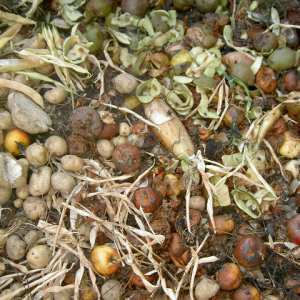 Gardening is the best way to fight back against skyrocketing food prices and compost is the best way to provide rich loam to the garden that will grow healthy, lush fruits, vegetables and herbs. Who would’ve guessed? Actually, composting can be fun! Instead of boring trips to the garbage bin, you can route household fruits and vegetable scraps to the compost. Coffee grounds, leaves and yard clippings can get thrown in as well. You’ll want to mix a compost every once in a while, but other than that, it can be left alone to meld and become that fragrant, rich loam that plants love. It isn’t a great idea to add meat or dairy products in with compost because they have a shelf life of Methuselah, which means it will take forever for these products to break down. Plus they may introduce unfriendly bacteria to the garden. However, compost is not picky and is are quite happy with animal wastes, so if you’re raising chickens, goats, or any other homestead animals add their “clean-out” materials, including hay, in with compost.
Gardening is the best way to fight back against skyrocketing food prices and compost is the best way to provide rich loam to the garden that will grow healthy, lush fruits, vegetables and herbs. Who would’ve guessed? Actually, composting can be fun! Instead of boring trips to the garbage bin, you can route household fruits and vegetable scraps to the compost. Coffee grounds, leaves and yard clippings can get thrown in as well. You’ll want to mix a compost every once in a while, but other than that, it can be left alone to meld and become that fragrant, rich loam that plants love. It isn’t a great idea to add meat or dairy products in with compost because they have a shelf life of Methuselah, which means it will take forever for these products to break down. Plus they may introduce unfriendly bacteria to the garden. However, compost is not picky and is are quite happy with animal wastes, so if you’re raising chickens, goats, or any other homestead animals add their “clean-out” materials, including hay, in with compost.
Compost can be au-natural, left to sit in a pile, but be sure to cover it with plastic or a tarp so it doesn’t get soggy with rainfall and turn into a stinking, heaping mess. If you’re fastidious (someone who mows their lawn in a diamond pattern, perhaps?), then you might want to keep compost in a closed bin with a lid. If you happen to have one made of wood slats that have gaps, protect the sides with a little straw. Once the materials have sat for a sufficient amount of time for everything to “meld”, it’s time to add it in with the garden soil. There are no specific time lines I can give for how long it will take your compost to be ready for the garden, for it all depends upon the materials you use.
A worm farm can be great entertainment, especially for us country folk who are easily entertained. And they benefit the garden by tunneling into the earth, opening up the soil, and exposing it to the air. This tunneling enriches the soil with nutrients for the lush garden plants we desire, and it helps with irrigation as we water our plants. Their travel through the soil leaves room for the delicate root system of plants to branch out, offering them better absorption for nutrients and moisture. Not only that, but the worm’s waste product contributes phosphorus, potassium, and nitrogen to the soil that greatly benefits the health of fruits, vegetables and other garden plants.
It may be hard to view the common earthworm as the pit-bull of the garden, but in many ways they are! An earthworm’s waste product acts as a natural repellant for garden pests and it helps to protect garden soil from disease. To make a worm farm, all you need is a container, shredded newspaper, soil and worms.
How to Make a Worm Farm
Scrounge or purchase a bin around 2 feet X 3 feet that’s at least 12 inches tall. Make a “nest” of shredded paper to approximately 8 to 10 inches high. Next, mix in 1 to 1 ½ pounds of rich garden soil. The final step to make their house a “home” is to add water to moisten, not soak, the contents, and mix the shredded paper and the soil together. Before introducing your worms to their new home, let the moistened soil and shredded paper sit for 48 hours to meld. Worms thrive in temperatures of between 60 to 90 degrees. Any hotter or colder may have you tossing out their poor little corpses, so heed the temperature of where you place them! If you are someone who enjoys digging, you can collect your own earthworms, or you can go online and order them.
Even if you’re the consummate procrastinator and plan to start a garden about the time you must take a loan out to pay the grocer’s, you’ll want to get the garden area ready as soon as possible. And don’t get cranky about having one more thing on your plate. Gardening experts recommend that soil preparation should be done 6 months before planting.
*********
The preceding was a guest post for Survival by author Barbara Fix.
Visit Survival Diva Blog http://www.survivaldiva.com/ for more information on rural living, gardening, home canning, food storage, and tips on combating skyrocketing food prices.
Survival Diva, Barbara’s preparedness book is available at http://www.survivaldiva.com/ Download for just $7.75









